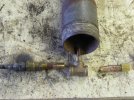- Joined
- Oct 3, 2005
- Messages
- 411
I built my first venturi forge. I am having trouble getting it to burn completely. Big yellow flame coming out the front, only getting up to 1500F
My burner tube is 12" long 1" pipe, bell reducer is 1.5", orifice is #53 drill bit size. 6 psi on the propane regulator.
orifice is shoved as far as I can get it in the bell. It burns worse the more I slide the orifice out of the bell.
I think I need it to pull more air, or reduce my orifice size.
Will a bigger bell reducer give me more or less air flow/velocity?
I can't wait to get this going good, it has such a nice swirl going on!
Any help is appreciated!
My burner tube is 12" long 1" pipe, bell reducer is 1.5", orifice is #53 drill bit size. 6 psi on the propane regulator.
orifice is shoved as far as I can get it in the bell. It burns worse the more I slide the orifice out of the bell.
I think I need it to pull more air, or reduce my orifice size.
Will a bigger bell reducer give me more or less air flow/velocity?
I can't wait to get this going good, it has such a nice swirl going on!
Any help is appreciated!
Last edited:

